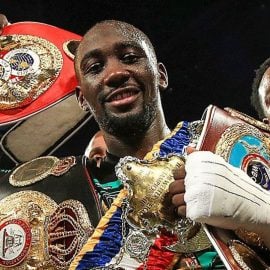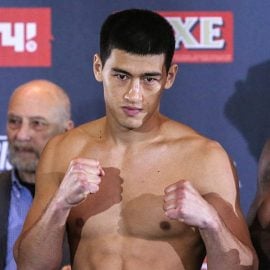Canelo Alvarez, Callum Smith and DAZN
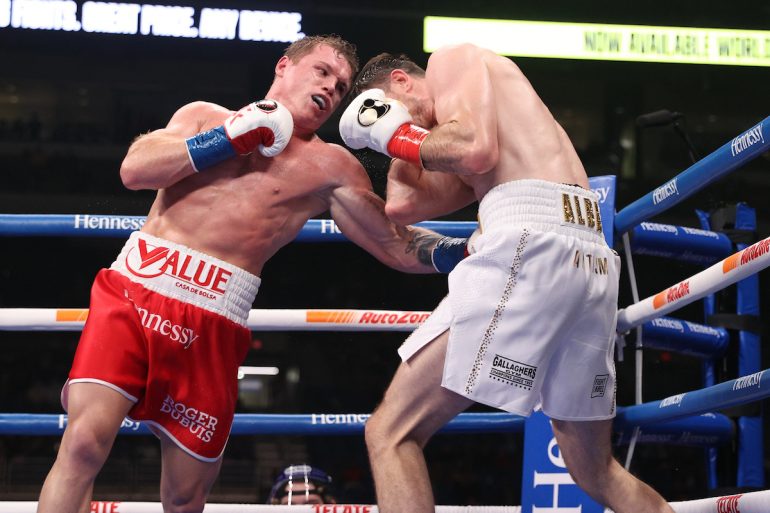
Earlier this year, Norm Frauenheim wrote, “Canelo Alvarez is fighting for history. But history, like profit, has been suspended for who-knows-how-long because of COVID-19. Alvarez is lucky. He was a wealthy man before the virus appeared and spread its deadly appendages like a weapon of mass destruction. Over just three fights in his rich DAZN deal, he earned $97.5 million. Canelo doesn’t have to fight, unlike most in the prizefighting profession. But if money isn’t a motivation anymore, Canelo’s immense pride is. For Alvarez, history isn’t complicated. It’s simple. Julio Cesar Chavez is the defining face of Mexico’s fabled boxing history. He was when Canelo was born in 1990. He has been ever since. Canelo had begun his monumental pursuit of supplanting Chavez. His run at history was underway. Now, a pandemic-altered landscape includes a potential dilemma for Canelo. History or profit? Money or legacy? Canelo’s claim on legacy is hard to make, much less sustain, when he’s not fighting. Inactivity opens the way to a skepticism that’s hard to counter. Canelo has to fight. But the world is operating on a different timetable these days. Tick-tock, we’re all on the pandemic clock.”
On Saturday night (December 19), Canelo resumed his quest for greatness and reasserted his claim to the No. 1 pound-for-pound ranking in boxing today with a dominant 12-round victory over Callum Smith at The Alamodome in San Antonio. There were numerous twists and turns in the road he followed to get there.
On October 17, 2018, it was announced that DAZN, Canelo, and Golden Boy (Canelo’s promoter at the time) had entered into a contractual relationship to stream Canelo’s next 11 fights on DAZN platforms throughout the world. With certain exceptions, DAZN would pay Golden Boy $40 million for each fight card headed by Canelo, and Golden Boy would pay Canelo $35 million of that. This would leave Golden Boy with $5 million plus the live gate and other revenue streams to pay Canelo’s opponent, each of the undercard fighters, the host site, and other promotional expenses. What was left over would be Golden Boy’s profit.
Then DAZN got buyer’s remorse and took a position of dubious legal merit.
Under the contractual relationship, Canelo was obligated to fight one “premier” fighter during each corporate year. DAZN took the position that Danny Jacobs and Sergey Kovalev (who Canelo fought on DAZN) weren’t premier fighters and that, unless Golden Boy delivered a third fight between Canelo and Gennady Golovkin, the promoter would be in breach of its contractual obligations. DAZN also listed several fighters other than Golovkin who would qualify as premier opponents. But these names were so impractical as to suggest bad faith on the network’s part (e.g Conor McGregor and Oscar De La Hoya).
On September 8, 2020, Canelo filed a lawsuit against DAZN and Golden Boy. Most likely, he would have prevailed in court. But litigation is expensive and would have put his career on hold with no guarantee that he’d be able to collect whatever judgment he won. On November 6, it was announced that the case had been settled and Canelo was now free of any future obligations to Golden Boy or DAZN.
The settlement formally terminated Golden Boy’s lucrative contractual relationship with Canelo. But that relationship had been on shaky ground for some time. And Golden Boy had no realistic choice but to accede to the settlement because Golden Boy CEO Oscar De La Hoya had significant personal financial exposure in the litigation and Golden Boy needs the license fees it receives from DAZN in conjunction with other fighters to navigate boxing’s perilous pandemic-swept waters.
When Canelo’s free agency became a reality, he had multiple suitors. No one offered a longterm $35 million per fight guarantee. But he wasn’t going to go poor either.
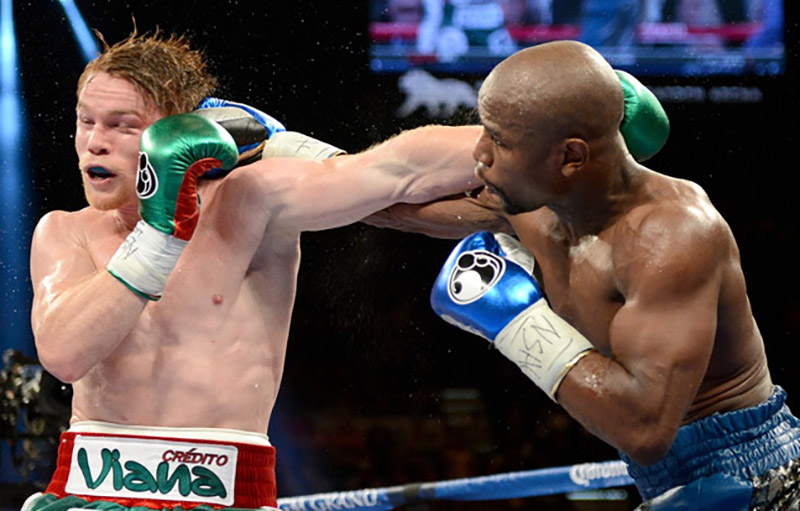
Canelo was outpointed by Mayweather in a 2013 superfight aired on Showtime. Photo by Naoki Fukuda
Canelo had fought on Showtime multiple times before leaving the network for HBO. Most notably, he’d battled Floyd Mayweather in a 2013 megafight on Showtime PPV. Shortly after Canelo’s lawsuit against DAZN and Golden Boy was filed, Showtime Sports president Stephen Espinoza told Forbes, “We’re proud of the time we spent with Canelo. We did some important fights in his career and we helped launch him as a pay-per-view attraction in the United States. We’d love to be in business with him again. We’re obviously going to respect his existing contracts. We’re not going to run afoul of that. If there’s a time when he’s available, we’ll be very aggressive. We have a lot of offer. As soon as there’s some clarity, we’d love to have the discussion.”
After Canelo’s lawsuit was settled, Al Haymon entered the sweepstakes, offering Canelo a three-fight deal for $75 million. The first fight would have been against Caleb Plant. One of the next two opponents would have been Jermall Charlo at a 166-pound catchweight. Alvarez said he’d fight Plant for $25 million but didn’t want to commit to three fights at those numbers.
Then, on November 17, Canelo tweeted that his next fight would be against Callum Smith on December 19 and that (to the surprise of many) the fight would be streamed on DAZN. The promoter would be Matchroom Boxing, which promotes Smith and, more significantly, has an intricate financial relationship with DAZN. Multiple sources say that Canelo and his team received $25-to-25.5 million for the fight. Slightly more than $5 million was allocated for Smith’s services.
Smith, a Liverpool native, is 30 years old (the same age as Canelo). Over the years, he’d compiled a 27-0 (19 KOs) ring record and collected the Ring Magazine and WBA super middleweight belts. There was a time when he was touted as a potential star. But he’d yet to beat a fighter of note other than a 2018 stoppage of a shopworn George Groves in the last fight of Groves’ career. Most recently, Callum had won a lackluster decision over John Ryder.
Four years ago, Canelo fought Smith’s older brother, Liam, at 154 pounds and knocked him out in the ninth round.
Tickets for Canelo-Smith went on sale on November 25 (one day before Thanksgiving). Buyers were advised that there would be limited capacity at the 72,000-seat Alamodome with up to 15,000 fans seated in socially distanced clusters. Ticket prices ranged from $2,005.50 down to $80.50. Buyers who went to Ticketmaster on the first day of sales saw a pop-up window that advised, “Prices may fluctuate based on demand at any time.” One day before the fight, some prices had been cut in half.
The mix of glitz and glamour normally associated with a Canelo fight week was absent from the scene. “You don’t see the people,” Canelo noted. “You don’t see the flags. You don’t see everything that surrounds fight week. But for the most part, it’s very similar to what I do. I stay in my room, focus, take care of media, all of that; stay focused and get ready for what’s coming.”
Smith, for his part, observed, “I’m in the position I’ve always wanted to be since I was a little boy. I want to test myself against the biggest names in the sport, and Canelo certainly is that . . . Four weeks’ notice for the biggest fight possible isn’t ideal. However, given the times that we’re in, I kind of expected to get it at late notice. And I wasn’t sitting around doing nothing. I’ve been in the gym. I have been training. I’m a winner, and I don’t take fights [just] for a payday.”

Canelo and Callum Smith on the scales. Photo by Ed Mulholland/Matchroom
Each fighter weighed in at 168 pounds, but there was a huge disparity in height between them. Smith, at 6-feet-3-inches, is a tall super middleweight. Canelo is six inches shorter. Canelo’s fight against Sergey Kovalev had given Callum what he thought was a blueprint for beating Canelo: Jab, use your superior height and reach to keep him at bay, pile up points, and – this is the hard part – take Canelo’s punches when they land and don’t get tired.
Despite holding two 168-pound belts, Smith walked to the ring and was introduced first, reflecting the relative status of the two fighters. The crowd was overwhelmingly behind Canelo, a 5-to-1 betting favorite.
My notes on the fight read as follows:
Round 1 – A feeling-out round with Canelo moving forward. Smith not throwing his jab.
Round 2 – Smith throwing a little more but Canelo still stalking. Neither fighter landing much.
Round 3 – Canelo still stalking, closing the gap. Smith very cautious, not fighting tall.
Round 4 – Canelo backing Smith up against the ropes, landing solid blows.
Round 5 – Smith trying to fight more aggressively. But Canelo is hard to hit and hits harder.
Round 6 – Smith a bit more effective because he’s staying off the ropes. But Canelo’s body shots are taking a toll.
Round 7 – Canelo patient, cutting off the ring well and landing.
Round 8 – Canelo asking questions, and Smith has no answers. When Smith lands, Canelo comes back harder.
Round 9 – Both men landing their best punches so far. But Canelo is landing more often and harder. Much harder.
Round 10 – Canelo putting a beating on Smith with hurting body blows.
Round 11 – Smith fighting courageously but his cause is hopeless.
Round 12 – Canelo looking to finish with a knockout. Smith has never been knocked off his feet before and hangs tough until the end.
I gave Canelo every round. Two of the judges (Steve Weisfeld and Rafael Ramos) scored it 119-109. Steve Morrow had it 117-111 which is a bit hard to fathom.
“I reached the top of the mountain and now I’ve been knocked off it,” Smith acknowledged in a post-fight interview. “He’s got everything.”
“I showed what I am,” Canelo offered.
He certainly did. Canelo keeps getting better as a fighter. He has “man strength” now and is hitting harder than before. He’s also wiser and has added wrinkles to his defense. He’s the best fighter in the world.
So . . . What does Canelo’s victory over Smith mean for boxing?
Among other things, it fits within the narrative of what’s happening at DAZN.
Two years ago, DAZN announced its intention to change boxing’s business model. It pledged “an end to pay-per-view” and promised to deliver pay-per-view quality fights to subscribers in the United States for the modest sum of $9.99 a month (later increased to $19.99 per month or $99.99 for a one-year subscription). It signed Canelo and Golovkin to multi-fight deals, contracted with Golden Boy and the World Boxing Super Series for additional fights, and gave Matchroom CEO Eddie Hearn in the neighborhood of $125 million a year to deliver more boxing.
That got everyone’s attention. Then things soured.
DAZN’s anchor sport in the United States is boxing. Its primary sport worldwide is soccer and 90 percent of its business is outside of the United States. Bloomberg.com says that, worldwide, DAZN lost $627 million in 2018 (the most recent year for which financials are publicly available).
Meanwhile, DAZN overestimated the demand for boxing in the U.S. market. It has been plagued by a poor business model and has not used its resources efficiently in buying content. Fighters have been signed pursuant to poorly drawn contracts (e.g. DAZN failed to lock in a third fight between Canelo and Golovkin). And Matchroom has failed to deliver content commensurate with the license fees that it has paid to fighters.
“Eddie Hearn,” one observer noted, “spent DAZN’s money like it was DAZN’s money.” For example, Matchroom signed Tevin Farmer to a four-fight deal worth approximately $2 million plus the fee that Matchroom paid to Farmer’s promoter, Lou DiBella.
DAZN won’t reveal the number of current subscribers that it has in the United States. But the network spent close to $10 million in license fees for a February 29, 2020, card headlined by Mikey Garcia vs. Jesse Vargas. One informed source says that this card engendered a meager 20,000 new subscriptions, most of which were not renewed.
In March 2020 as COVID-19 spread, DAZN suspended the payment of rights fees for events that were postponed and other content that wasn’t delivered to its platforms in nine countries around the world. This led to claims of breach of contract lodged by Major League Baseball and other content providers. Meanwhile, boxing ground to a halt.
The pandemic improved DAZN’s short-term balance sheet in America because it brought the network a modicum of relief from some of its financial obligations. Also, many subscribers didn’t take the steps necessary to cancel their monthly subscriptions. But the lethargy of subscribers is not a good business model. And given DAZN’s contractual history with Major League Baseball, Canelo and others, some content providers will be reluctant to engage with the network in the future – particularly since DAZN lacks a broad platform to attract prospective viewers. Visibility and trust are important concepts.
The bottom line is that, to date, DAZN has spent hundreds of millions of dollars in the United States to build what is essentially a niche boxing channel. It should also be noted that DAZN jumpstarted the trash-boxing carnival with its streaming of Logan Paul vs. KSI on November 9, 2019, but was bypassed when the big money started rolling in with Mike Tyson and Roy Jones.
A look at DAZN’s boxing offerings in the United States in 2020 is instructive. Its main events for the first 11 months of the year were:
January 11 – Jamie Munguia vs. Gary O’Sullivan
January 23 – Jason Quigley vs. Oscar Cortes
January 30 – Demetrius Andrade vs. Luke Keeler and Jake Paul vs. AnEsonGib
February 6 – Ricardo Sandoval vs. Raymond Tabugon
February 8 – Kell Brook vs. Mark DeLuca
February 14 – Ryan Garcia vs. Francisco Fonseca
February 29 – Mikey Garcia vs. Jessie Vargas
March 7 – Scott Quigg vs. Jono Carroll
July 24 – Vergil Ortiz vs. Samuel Vargas
August 1 – Sam Eggington vs. Ted Cheeseman
August 7 – Terri Harper vs. Natasha Jonas
August 14 – Felix Cash vs. Jason Welborn
August 15 – Cecilia Braekhus vs. Jessica McCaskill
August 22 – Dillian Whyte vs. Alexander Povetkin
September 25 – Julio César Chávez Sr. vs. Jorge Arce 3 (exhibition)
September 26 – Mairis Briedis vs. Yuniel Dorticos
October 4 – Joshua Buatsi vs. Marko Calic
October 17 – Lewis Ritson vs. Miguel Vazquez
October 23 – Juan Francisco Estrada vs. Carlos Cuadras
October 30 – Jaime Munguia vs. Tureano Johnson
October 31 – Aleksandr Usyk vs. Derek Chisora
November 7 – Devin Haney vs. Yuriorkis Gamboa
November 14 – Katie Taylor vs. Miriam Gutierrez
November 21 – Conor Benn vs. Sebastien Formella
November 27 – Danny Jacobs vs. Gabriel Rosado
That includes an understandable four-month shutdown because of the pandemic.
These are not the “pay-per-view quality” fights that DAZN promised its subscribers when the network launched and began accepting subscription dollars. A skeptic might argue that some of them aren’t even “YouTube-quality” fights.
DAZN is ending 2020 in more credible fashion with the following main events for December:
December 4 – Billy Joe Saunders vs. Martin Murray
December 12 – Anthony Joshua vs. Kubrat Pulev
December 17 – Samuel Gonzales vs. Devis Boschiero
December 18 – Gennadiy Golovkin vs. Kamil Szeremeta
December 19 – Canelo Alvarez vs. Callum Smith
It remains to be seen whether December is a harbinger of things to come or merely a push to meet certain year-end economic metrics. In terms of boxing content, DAZN is finishing 2020 stronger than any other network. But that was true of 2019 too.
Meanwhile, the leadership team at DAZN has been changing. On June 29, it was announced that Simon Denyer was leaving his role as chief executive officer of DAZN Group (which oversees DAZN’s global operations) and would be replaced by James Rushton, who previously had been DAZN’s chief revenue officer. John Skipper remained as executive chairman of DAZN Group.
Now, a source says, key decisions at DAZN are being made by Ed McCarthy (DAZN’s chief operating officer in London and a lawyer by trade who formerly worked for Access Industries). Access Industries is Len Blavatnik’s holding company. Blavatnik is a Ukranian-born billionaire with U.K. and U.S. citizenship who has funded DAZN from its inception.
“McCarthy is the new number-one guy,” the source says. “Skipper has been marginalized and [executive vice president for North America] Joe Markowski can no longer sign off on significant decisions without approval from above.”
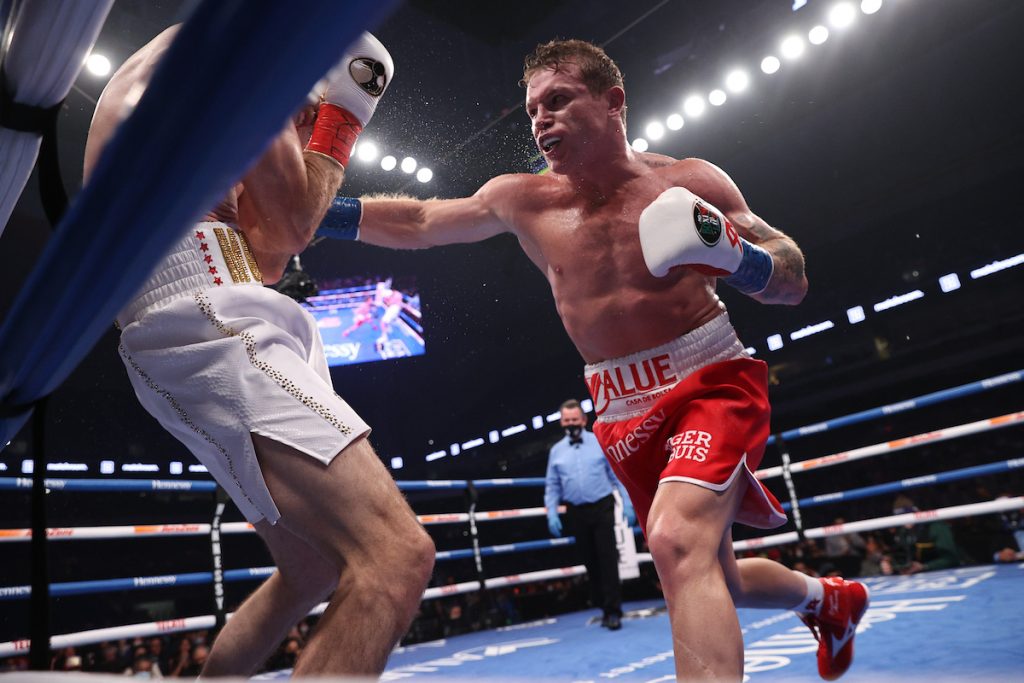
Photo by Ed Mulholland/Matchroom.
Canelo vs. Callum Smith served as the launching pad for two changes in DAZN’s economic model.
The first change was long in coming. After a false start this spring occasioned by the pandemic, DAZN rolled out a worldwide English-language app that it had originally intended to introduce in conjunction with a planned May 2 fight between Canelo and Billy Joe Saunders. The app, which DAZN says is available on most internet-connected devices, was announced as having an initial monthly price point in new markets of 1.99 pounds ($2.70) or less. This leads to the question of whether, at some point, DAZN will close down its network in the United States and America will be just one more country with access to the English-language app.
The second change is more intriguing. On December 15 (four days before Canelo-Smith), DAZN announced that the fight would be available in the United States through traditional pay-per-view channels for $69.99. Purchasers will also receive a four-month subscription (January through April 2021) to DAZN.
According to ProSportsMedia.com, distribution of the pay-per-view was facilitated by In Demand (which reaches 55 million homes through cable systems like Comcast, Cox Communications, Charter Communications, AT&T and Verizon). The distributors will receive a cut of revenue from the initial purchase and also “share in the money brought in from new DAZN subscribers who choose to keep paying for the service after their four-month trial expires.”
The transition to a pay-per-view hybrid is a major change in strategy for DAZN and an acknowledgement that its previous “pay-per-view is dead” mantra is no longer operative.
Supporters of DAZN’s pay-per-view gambit say it shows that network executives are constructively evolving in their thinking and that the plan will encourage buyers to sample DAZN during the first four months of 2021. They also believe that the $69.99 price point will reinforce the value of DAZN’s one-year subscription offer.
But there were – and still are – potential problems. Apart from possible technological issues, it’s virtually impossible to market a pay-per-view fight on four days’ notice. Further to that point, when a promotion makes a deal with a cable system to carry a pay-per-view event, the system generally commits to marketing in support of the event (which wasn’t feasible on a large scale here).
Many consumers, even if they knew about the Canelo-Smith pay-per-view option, didn’t know how to place an order. And people who did know were probably savvy enough to know that they could buy a one-month subscription for $19.99 and then cancel instead of paying $69.99.
Also, there’s the question of whether this is a stand-alone move for Canelo’s fights or DAZN will offer similar pay-per-view bundles for other fighters in the future. And will DAZN at some point charge regular subscribers extra for big fights the way ESPN+ charges subscribers extra for major UFC cards? DAZN might say now that this won’t happen. But this is the same network that, for two years, assured the public that “pay-per-view is dead.”
If DAZN is to succeed in the United States, it has to show subscribers that it’s worth having all the time. As of this writing, it has scheduled six fight cards for 2021. On January 2, Ryan Garcia will face Luke Campbell in an attractive offering that will serve as a measuring stick for Garcia. On January 30, Sergey Kovalev will take on Bektemir Melikuziev in an outing that’s largely about making good on a contractual commitment to Kovalev in conjunction with his 2019 bout against Canelo. The contract weight for Kovalev-Melikuziev is 178 pounds. Melikuziev has had only six professional fights and last fought at 168 pounds. Other announced fights on DAZN include David Avanesyan vs. Josh Kelly (in a separate event on January 30); a doubleheader featuring JoJo Diaz Jr. vs. Shavkatdzhon Rakhimov and Patrick Teixeira vs. Brian Castano on February 13; Joseph Parker vs. Junior Fa on February 27; and Roman “Chocolatito” Gonzalez vs. Juan Francisco Estrada on March 13. Most of these fights will be of limited interest in the U.S. market.
At present, two potential fights are of particular interest to senior management at DAZN. The first of these is a possible third encounter between Canelo and Gennadiy Golovkin. Gennadiy’s “Big Drama Show” has worn thin. There’s not much drama in watching GGG beat up 20-to-1 underdogs like Kamil Szeremeta – a club fighter from Poland who for reasons unknown (but likely having to do with money) was the IBF’s mandatory challenger. Golovkin-Szeremeta was a horrible mismatch and, other than the introduction of Chris Algieri (who did an excellent job as an expert analyst) reflected poorly on the state of boxing and DAZN.
But Canelo-Golovkin III would be an interesting fight, albeit not as marketable as it would have been two years ago. Indeed, Golovkin’s value to DAZN is based largely on that fight. Without it, he’s seen primarily as a cash drain with an overpriced contract and a possible opponent for Demetrius Andrade (whose contract is another source of tsoris for DAZN).
And then there’s the big one – Tyson Fury vs. Anthony Joshua. DAZN has streamed Joshua’s last four fights in the United States. But its deal with Matchroom (Joshua’s promoter) for Anthony’s services is on a fight-by-fight basis.
 DAZN’s embrace of a hybrid pay-per-view model might open the door to its participating in Fury-Joshua.
DAZN’s embrace of a hybrid pay-per-view model might open the door to its participating in Fury-Joshua.
BT Sport and Sky Sports have rights to Fury and Joshua respectively in the United Kingdom. ESPN has a position with regard to Fury in the United States. And it’s hard to imagine ESPN saying, “Sure, you can put Fury-Joshua on DAZN.” One of the last things ESPN wants to do is help build DAZN as a competitor for ESPN+.
But there are whispers that, if Fury-Joshua is held outside the United States or United Kingdom (for example, in the Middle East), Fury would be a free agent insofar as pay-per-view rights in America are concerned. Both Queensberry (Fury’s U.K. promoter) and Top Rank (his American promoter) have declined requests from The Ring that they clarify this issue.
What will happen to DAZN?
For the near future, Len Blavatnik will probably keep supplying the funds necessary to keep it afloat. According to the latest Bloomberg Billionaires Index, Blavatnik is worth $33 billion ($8 billion more than last year).
Blavatnik is said to be considering an effort to recoup his investment in DAZN through the sale of public stock. Alternatively, he might keep DAZN USA alive, build DAZN’s other platforms throughout the world, and cut his losses down the road by selling the entire network to an entity that wants to get into sports video streaming worldwide without having to start from scratch.
Putting a positive spin on things, DAZN can say, “Look, 2020 was a challenging year for everyone and it accelerated some longterm trends like more people cutting their cable cord and signing up for streaming services. Media models change quickly today. We’re in the right place at the right time. And don’t forget, Netflix has seen an extraordinary rise in the value of its stock despite having a lot of red ink on its balance sheet.”
But Netflix has built a huge platform while DAZN has had little subscriber growth. And streaming video is not a formula for guaranteed success.
The Walt Disney Company is at one end of the spectrum. When Disney+ launched in November 2019, Disney said that it hoped to reach 90 million subscribers by 2024. Then, on December 10, 2020, the company announced that Disney+ had amassed 86.6 million worldwide subscribers. Disney stock jumped 13.6 percent the following day. By contrast, HBO Max (another big-name streaming service) is struggling.
And by the way, subscribers can get a bundled package of Disney+, ESPN+ and Hulu for $12.99 a month (which is 35 percent less than the monthly cost for DAZN).
But let’s put the business end of things aside in closing and return to Canelo Alvarez. Canelo is the brightest star in today’s boxing firmament. He has been fighting professionally for 15 years. The list of fighters he has beaten compares favorably with the victims on Julio Cesar Chavez’s ring ledger. Canelo’s quest for the most exalted place in Mexican ring lore is not quixotic.
Thomas Hauser’s email address is [email protected]. His most recent book – Staredown: Another Year Inside Boxing – was published by the University of Arkansas Press. In 2004, the Boxing Writers Association of America honored Hauser with the Nat Fleischer Award for career excellence in boxing journalism. In December 2019, it was announced that he had been selected for induction into the International Boxing Hall of Fame.
SUBSCRIBE NOW (CLICK HERE - JUST $1.99 PER MONTH) TO READ THE LATEST ISSUE









